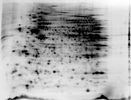| General information about the entry |
| View entry in simple text format |
| Entry name | RD23B_HUMAN |
| Primary accession number | P54727 |
| integrated into World-2DPAGE Repository (0054) on | November 28, 2012 (release 1) |
| 2D Annotations were last modified on | November 28, 2012 (version 1) |
| General Annotations were last modified on | October 23, 2014 (version 2) |
| Name and origin of the protein |
| Description | RecName: Full=UV excision repair protein RAD23 homolog B; Short=HR23B; Short=hHR23B; AltName: Full=XP-C repair-complementing complex 58 kDa protein; Short=p58;. |
| Gene name | Name=RAD23B
|
| Annotated species | Homo sapiens (Human) [TaxID: 9606] |
| Taxonomy | Eukaryota; Metazoa; Chordata; Craniata; Vertebrata; Euteleostomi; Mammalia; Eutheria; Euarchontoglires; Primates; Haplorrhini; Catarrhini; Hominidae; Homo. |
| References |
| [1] |
2D GEL CHARACTERIZATION
DOI=10.1074/mcp.M112.022947;
Vernocchi S., Battello N., Schmitz S., Revets D., Billing A.M., Turner J.D., Muller C.P.
''Membrane glucocorticoid receptor activation induces proteomic changes aligning with classical glucocorticoid-effects''
Molecular & Cellular Proteomics 12(7):1764-1779 (2013)
|
|
| 2D PAGE maps for identified proteins
|
|
How to interpret a protein
|
HSAPIENS_CCRF-CEM_3-10 {CCRF-CEM cells stimulated with Cort-BSA (internal standard)}
Homo sapiens (Human)

map experimental info
|
|
HSAPIENS_CCRF-CEM_3-10
MAP LOCATIONS:
%COV: SPOT 631: 35 [1].
SCORE: SPOT 631: 244 [1].
SEARCH ENGINE: SPOT 631: Mascot [1].
MAPPING (identification):
|
| Copyright |
| Data from Dr. Claude P. Muller, Centre de Recherche Public de la Sante / National Public Health Laboratory, Luxembourg |
| Cross-references |
| UniProtKB/Swiss-Prot | P54727; RD23B_HUMAN. |